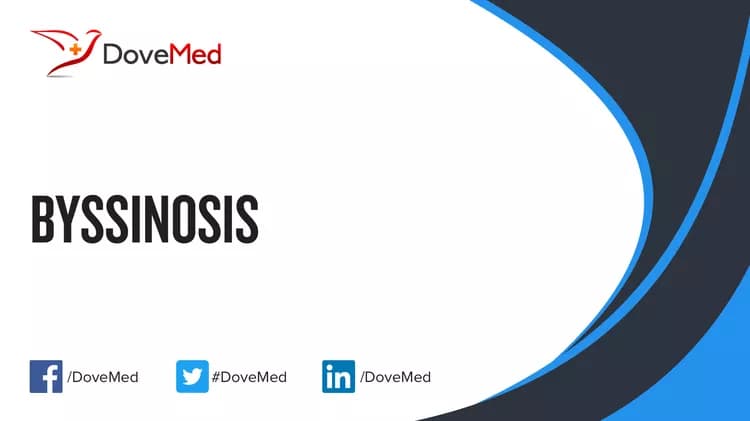What are the other names for this Condition? (Also known as/Synonyms)
- Brown Lung Disease
- Cotton Workers’ Lung
- Mill Fever
What is Byssinosis? (Definition/Background Information)
- Byssinosis is a lung disease caused by inhaling dust from cotton or vegetable fibers, usually from one’s work environment
- Byssinosis may cause breathing difficulty similar to asthma. It generally starts at the beginning of the work week, and improves as the week progresses and the exposure to dust is removed (such as on the weekend)
- Byssinosis develops due to inhalation of dust produced by raw cotton and other textiles in the workplace, which carry biological materials that are harmful to the human body
- The best method of treatment for Byssinosis is to avoid the occupational cause. Bronchodilators and anti-inflammatory medication may also be used for short-term relief
- The prognosis of Byssinosis is typically good and the condition improves once the affected individual removes himself/herself from the harmful environment
- However, a prolonged exposure to dust in the workplace can result in irreversible and chronic lung disease, with significant complications
Who gets Byssinosis? (Age and Sex Distribution)
- Byssinosis is a rare condition that is most commonly seen in individuals working with unprocessed cotton
- Both males and females are equally likely to be affected by this condition
- Byssinosis can affect individuals of all racial and ethnic groups
- However, it is more commonly seen in developing countries, where safety work measures may not be adequate or strictly enforced
What are the Risk Factors for Byssinosis? (Predisposing Factors)
Some known risk factors for Byssinosis include:
- Working in the textile industry
- Smoking cigarettes
- Personal and/or family history of asthma or allergies
It is important to note that having a risk factor does not mean that one will get the condition. A risk factor increases one’s chances of getting a condition compared to an individual without the risk factors. Some risk factors are more important than others.
Also, not having a risk factor does not mean that an individual will not get the condition. It is always important to discuss the effect of risk factors with your healthcare provider.
What are the Causes of Byssinosis? (Etiology)
Byssinosis is primarily caused by environmental factors and may occur as a result of inhalation of dust particles from cotton, hemp, or flax within an industrial environment.
- Certain biological materials found in cotton, hemp, and flax may trigger an allergic reaction in susceptible individuals
- Release of endotoxins from the bacteria growing on cotton can result in the signs and symptoms of this condition
What are the Signs and Symptoms of Byssinosis?
The signs and symptoms of Byssinosis may include the following:
- Coughing, wheezing
- Fever
- Chest tightness
- Shortness of breath; difficulty breathing
- Muscle pain and joint pain
- Tiredness
How is Byssinosis Diagnosed?
A diagnosis of Byssinosis is made based on the information gathered from the following methods:
- Complete physical evaluation and an assessment of the presenting signs and symptoms
- Comprehensive analysis of medical history including evaluation about one’s occupation and work environment
- Imaging tests such as chest X-ray and CT scan
- Pulmonary function tests (or breathing tests)
- Differential diagnosis to rule out other disorders that may present with similar signs and symptoms
Many clinical conditions may have similar signs and symptoms. Your healthcare provider may perform additional tests to rule out other clinical conditions to arrive at a definitive diagnosis.
What are the possible Complications of Byssinosis?
The potential complications of Byssinosis include:
- Severe cough
- Persistent fever
- Extreme difficulty in breathing
- Severe joint and muscle pain, restricting movement
- Chronic lung disease (chronic bronchitis)
- In some cases, loss of work and mental stress due to health issues
How is Byssinosis Treated?
The best method of treatment for Byssinosis is to avoid the occupational cause. However, this option may not feasible for affected individuals, and so, the following treatment methods may provide short-term relief:
- Bronchodilators to open constricted airways
- Inhaled corticosteroids to reduce lung inflammation
- Oxygen therapy to increase blood oxygen levels
- Breathing exercises and physical activity to improve lung health and negative symptoms
How can Byssinosis be Prevented?
Byssinosis may be preventable by considering the following factors:
- Avoiding workplaces with raw and unprocessed cotton and other such textile materials
- Wearing a mask for protection to prevent dust particles from being inhaled
- Smoking cessation
- Enforcing any governmental regulations on workplace safety and exposure to pollutants, chemicals, irritants, and such substances
- Creating an awareness amongst the workers and employers about the various substances that they may be exposed to at their workplace, and the possible health effects of these substances; especially for those who work in high-exposure (risk) areas
What is the Prognosis of Byssinosis? (Outcomes/Resolutions)
- Generally, the prognosis of Byssinosis is good. The condition is known to improve once the affected individual removes himself/herself from the harmful environment
- Prolonged exposure to dust in the workplace can result in irreversible and chronic lung diseases
Additions and Relevant Useful Information for Byssinosis:
- In the United States and many other countries, there may be worker’s compensation available to Byssinosis-affected individuals
The following DoveMed website link is a useful resource for additional information:
Related Articles
Test Your Knowledge
Asked by users
Related Centers
Related Specialties
Related Physicians
Related Procedures
Related Resources
Join DoveHubs
and connect with fellow professionals


0 Comments
Please log in to post a comment.